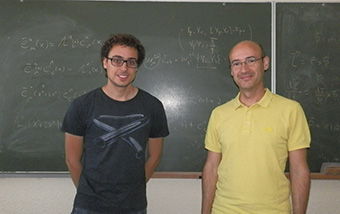
According to the study published by the researchers of the Institute of Corpuscular Physics (IFIC, CSIC-UV) in the journal “Classical and Quantum Gravity”, matter can probably survive its incursion into a black hole. The physicians propose analysing the singular nature of these objects, as if studying a flaw in the geometrical structure of space-time. Their interpretation solves a problem of infinity in the centre of a black hole.
One of the great problems one encounters when studying a black hole, is that the laws of physics stop making sense in its deepest regions. This place where great quantities of mass and energy are concentrated, takes the name of "singularity", and in space-time it curves towards infinity, thus destroying all matter. Or maybe not. According to the study published by researchers from Institute of Corpuscular Physics (IFIC, CSIC-UV) in the scientific journal "Classical and Quantum Gravity", matter might be able to survive the incursion into a black hole. The physicists propose analysing the singularity of these objects, as if studying a flaw in the geometrical structure of space-time. Their interpretation solves a problem of infinity in the centre of a black hole.
“Black holes are a theoretical laboratory for testing new ideas about gravity", says Gonzalo Olmo, researcher Ramón y Cajal from Universitat de València (UV) in IFIC. Together with Diego Rubiera, from University of Lisboa, and Antonio Sánchez, who is working on his doctorate at UV. Olmo analyses black holes using theories that go beyond General Relativity (Einstein´s theory which describes gravity and predicts the existence of these objects). This approach applies geometrical structures similar to those of a crystal or graphene sheets, which differ from ones traditionally used in this field.
According to Olmo, this type of geometries is better adapted to what happens inside a black hole. "Just like crystals have flaws in their microscopic structure, the central area of a black hole can be interpreted as an anomaly of space-time, which requires new geometric elements to be able to describe it with more precision. We are exploring all the possible options and we are inspired by phenomena that we observe in nature".
By linking gravity to this kind of geometries, the researchers obtain a description of a black hole where the central point turns into a spherical surface with a minimal area. This surface is interpreted as an existence of a wormhole, inside the black hole. "Our theory solves various problems in the interpretation of black holes with an electric charge", the researcher explains.
"This way, we would solve the problem of singularity, given that there is a ‘door’ in the centre of a black hole, a wormhole, thanks to which time and space can continue".
The researchers work with one of the simplest kinds of black holes, ones that do not turn but which have an electric charge. The wormhole that they predict via equations is smaller than the nucleus of an atom, but the larger the electric charge, the larger it becomes. Thus, the hypothetical traveller that falls into a black hole of this kind would be stretched when getting close to the centre, making it look like spaghetti and making it easy for it to enter the wormhole. After exiting, it would return to its original state.
Seen from the outside, these stretching and compaction forces would seem infinite, but the traveller himself, experiencing it first-hand, would "only" experience the forces as extremely intense, instead of infinite. It is unlikely that the protagonist could survive such a voyage, but according to the model proposed by the researchers at IFIC, matter would not get lost in the singularity of a black hole. Instead, it would be expulsed to another region of the Universe through a wormhole at its centre.
Another problem that can be solved by this interpretation, Olmo says, is the necessity of using "exotic" sources of energy to generate wormholes. In Einstein´s theory of gravity, these "doors" can only appear in the presence of matter with insular properties (negative pressure or energy density) which has never been observed. "According to our theory, the wormholes appear through ordinary energy and matter, the way it happens in an electrical field", the researcher assures.
The interest that wormholes have for theoretical physics goes beyond generating "tunnels" in space-time to connect two places in the Universe. It would also help to explain phenomena such as quantum entanglement or the nature of elementary particles. Thanks to this new interpretation, the existence of these objects can form a part of this Universe, and not only of science-fiction.
More information:
“Impact of curvature divergences on physical observers in a wormhole space–time with horizons”, Gonzalo J. Olmo, D. Rubiera-Garcia and A. Sanchez-Puente. Classical and Quantum Gravity, Volume 33, Number 11.
“Wormholes can fix black holes”, Gonzalo J. Olmo, D. Rubiera-Garcia and A. Sanchez-Puente.
https://cqgplus.com/2016/06/08/insight-wormholes-can-fix-black-holes/
Last update: 28 de july de 2016 09:29.
News release



















